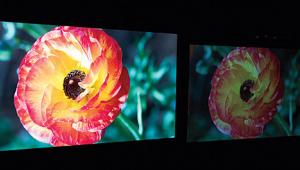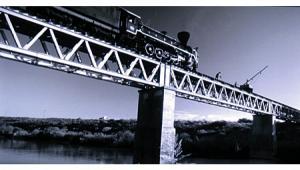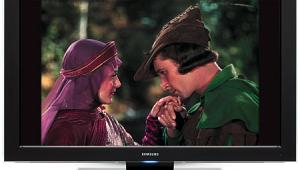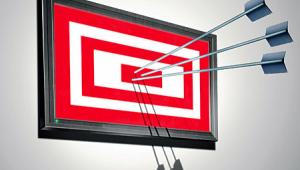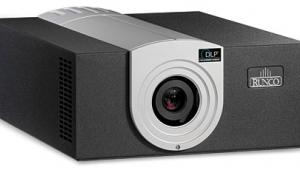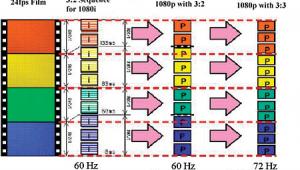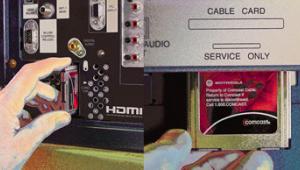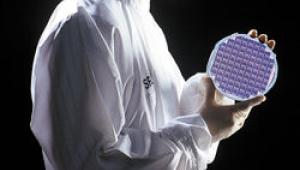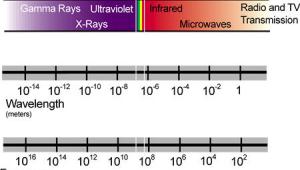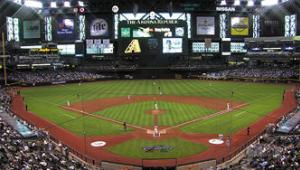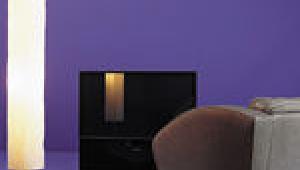Flat Panel Display Lab
Nestled deep within the corridors of the sprawling NIST (the National Institute of Standards) campus lives the Flat Panel Display Lab. This special facility is dedicated to the development and implementation of metrology, or the measuring methodology, for flat-panel displays. Founded in 1992 and located in Boulder, Colorado, the lab's scientists have created a comprehensive and robust set of measurement methods for accurately evaluating the quality and accuracy of displays.

FPDL manager Edward Kelley in the Lab.
Testing, One, Two, Three
The Flat Panel Display Lab initially came about when someone in NIST's upper management was asked when NIST was going to do something to support the display industry. Soon after, lab head Ed Kelly arrived, and for the next nine months, he studied the science and practice of flat-panel display technology. He discovered that the industry offered little in the way of standard tests to evaluate the quality of the products made. "We found out very quickly that many of the people making measurements were doing it wrong." This created a situation where published specifications from one manufacturer's display couldn't be directly compared with the specifications from another manufacturer's display. The Flat Panel Display Lab adopted a mission to create a battery of test methods that all manufacturers could use to determine the actual performance of their displays so that the end user could accurately compare flat-panel display performance.
You may wonder why a United States governmental facility makes its findings available to every company and individual regardless of their country of origin. The answer is quite simple: The U.S. remains the largest market for flat-panel displays in the world. Better and more consistent testing will result in better displays.

All of the Lab's meters are tested monthly.
Stupid Bright Room Tests
The two most important performance categories for any display device are contrast and color accuracy. Because of the nature of flat-panel devices, your viewing environment makes a major difference in the perceived contrast range of the display's picture. For years, display manufacturers used the "bright room test" to determine a display's contrast under normal room conditions. This test consisted of placing a bank of fluorescent lights that put out 100 Lux of light above the display and then measuring the black and white boxes of a standard checkered display pattern. The difference between the black box and the white box was the contrast ratio, although this test proved to be fundamentally flawed. First, the ambient light level in an average room is well above 100 Lux (closer to 300 to 400 Lux). More importantly, depending on the placement of the light and measuring device, measurements could vary as much as 1,000 percent. Even minute changes in the location of the light, measuring device, and even the size of the testing room can cause radically differing results, making this test virtually worthless for comparing displays made by different manufacturers, as each company conducted tests in their own unique facility. There had to be a better way.
The Flat Panel Display Lab developed a standard way to measure not only the reflectance of front-panel-display materials, but also a display's contrast under different ambient light levels. Their methodology involves using a closed chamber with critically even illumination and a carefully calibrated light level that techs can accurately reproduce day in and day out. Trained testing personnel can set up a chamber anywhere, and once it's properly calibrated, their tests will correlate with tests performed in other chambers anywhere in the world. This codification of testing procedures forms the backbone of the Flat Panel Display Lab's work.

A technician sets up her computer for the illumination boxes on her left.
Frustums in Action
What, you may well be wondering, is a frustum? It is a cone-shaped piece of shiny black plastic that drastically reduces veiling-glare effects during display testing. What is veiling glare? This phenomenon occurs when stray light bounces around inside your measuring device, causing false and inconsistent readings. According to NIST researcher Paul Boynton during one test, "A conventional test method resulted in a contrast value of 50:1; while using a frustum revealed a more accurate contrast ratio of 250:1." Using a frustum not only improves the accuracy of contrast tests, but also color and gray-scale measurements. Best of all, anyone can make a frustum because it doesn't involve esoteric materials or exotic manufacturing techniques. All you need is semi-rigid, shiny black plastic and tape. You can find instructions on the Flat Panel Display Lab's Website at www.fpdl.nist.gov. A couple of days after my visit to NIST, I made my own simple frustum and compared readings from a Philips PM 5639 color analyzer with and without the frustum. My conclusion: Frustums make for more accurate readings. Not only were my contrast readings more consistent, but my gray-scale readings were also more accurate. I encourage anyone who monitors measurements or calibrations to make themselves a frustum posthaste.

A Macbeth color chart in a controlled lighting box for color-calibration testing.
Along with information on frustums, you'll also discover a complete description of stray-light-elimination tubes or SLETs, or frustums on steroids. A SLET consists of a tube containing multiple frustums. Depending on the size of your calibration meter, a SLET can be the size of a paper-towel tube or a bazooka. The outer tube can be made of plastic, cardboard, metal, or fiberglass. At the Flat Panel Display Lab, some SLETs were high-tech slick, while others looked like products of a well-lubricated redneck science fair. But regardless of looks, a SLET can markedly increase the accuracy of display measurements.

Custom-built jigs for testing flat panels.
The Big Red Book
You can find all of the Flat Panel Display Lab's testing procedures in a thick, softbound book produced by VESA (Video Electronics Standards Association), aptly titled Flat Panel Display Standards. If you want a copy, consider taking the Display Metrology Short Course. NIST holds this one-week class (the tuition cost is $1,900) about four times a year at the Boulder facility, depending on demand. Most of the participants are employees from major flat-panel manufacturers trying to get up to speed on the latest testing techniques. Members of VESA can also get copies of the book; but without the course, much of the information (except for the clever cartoons peppered throughout) is more than most can comfortably swallow. A better reading choice would be Tips for Buying an HDTV, Flat-Panel Television, or a Large-Screen FPD TV. This 28-page PDF document has an intriguing subtitle: "If you have already purchased an FPD TV and are happy with it, you may not want to view these slides, as it may reduce your enjoyment of your TV. You have been warned." How's that for a government disclaimer? The article is also located on the NIST Website. It should give a you warm, fuzzy feeling to see tax dollars so well spent, so long as you don't already own a flat-panel monitor.
- Log in or register to post comments


